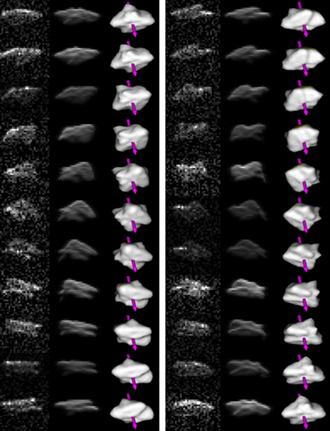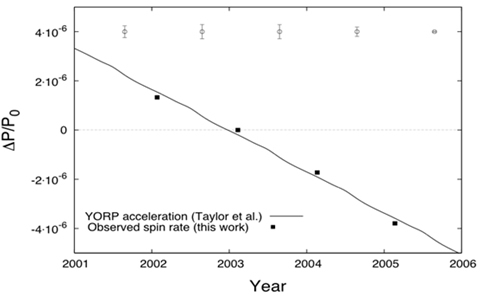The Asteroidal YORP Effect Observed
7 May, 2007 12:26 pm
For the first time, astronomers have witnessed the speeding up of an asteroid?s rotation rate (the YORP effect), and showed that it is due to a theoretical effect predicted but never observed. The international team of scientists used a suite of powerful telescopes to uncover that the asteroid is rotating faster by 1 millisecond every year, as a consequence of sunlight impinging upon its surface. Eventually it may spin faster than any known asteroid in the solar system and even break apart by rotational fission. These extraordinary findings are reported in two new companion papers in the journal Science.

Figure 1: Asteroid 2000 PH5 imaged with ESO’s 3.5m New Technology Telescope in Chile on August 27, 2003, over a time span of 77 minutes. The asteroid can be seen moving relative to the background stars (Credit: Stephen C. Lowry).
The Yarkovsky-O’Keefe-Radzievskii-Paddack effect (or YORP for short) is caused by sunlight striking the surfaces of asteroids. Light particles, or photons, have mass and so a small amount of momentum is transferred to the asteroid. At the same time, most of the sunlight is absorbed and re-radiated as heat giving rise to an even stronger recoil effect. If the asteroids’ shape is sufficiently irregular then a net torque can arise that will change how fast an asteroid spins, and even cause the direction of its spin axis to slowly drift. Although this is an almost immeasurably weak force, its effect over millions of years can have a significant effect.
The existence of such a process has never been confirmed by direct observation of the effect in action, and all we have seen so far are end products of YORP. For example, the surprising spin-axis alignments of members of the Koronis asteroid family requires some mechanism to be causing the steady drifting and eventual alignment of their spin axes, and YORP has been shown by theoreticians to be the culprit.
Astronomers believe the YORP effect may also be responsible for spinning some asteroids up so fast that they break apart by centrifugal forces, perhaps leading to the formation of binary asteroids or even multiple-asteroid systems. Others may be slowed down so that they take many days to spin once or cause some asteroids to rotate chaotically. Just as intriguing is that this small effect can play an important role in changing the orbits of asteroids between Mars and Jupiter, including their delivery to planet-crossing orbits, such as Near-Earth asteroids. Despite its importance and wide implications, the effect has never been seen acting on a solar system body.

Figure 2: Radar images obtained at the Arecibo facility in Puerto Rico on July 28, 2004, covering one full rotation of asteroid 2000 PH5 (columns 1 and 4). Corresponding shape-model fits to the images are shown in columns 2 and 5. Columns 3 and 6 are detailed 3-D renderings of the shape model itself (Credit: Taylor et al., Science 316, p274-277).
Using extensive optical and radar imaging from powerful Earth-based observatories, astronomers undertook the challenging task of measuring the YORP effect on an asteroid for the first time. Over a 4 year time span, Stephen Lowry from Queen’s University (UK) and colleagues took images of a small near-Earth asteroid, known as (54509) 2000 PH5, using a range of large telescope facilities in Chile, Spain, Czech Republic, the Canary Islands, and Hawaii. With these facilities the astronomers measured the tiny brightness variations as the asteroid rotated, providing a means to measure changes in the asteroids’ spin rate.
Near-Earth asteroid (54509) 2000 PH5, was discovered by the Massachusetts Institute of Technology Lincoln Laboratory’s near-Earth asteroid search program (LINEAR) on August 3rd 2000. It is one of only a handful of objects known to be co-orbital companions of Earth and approaches our planet annually to within just 5 lunar distances. This, along with its small size of 114m, makes it a perfect candidate for a first YORP detection. Furthermore, it was already spinning at an exceptionally fast rate with one ‘day’ on the asteroid lasting just over 12 minutes, and so the effect may have been acting on this asteroid for some time and still doing so.
The final result was even stronger than hoped. After careful analysis of the optical data, the asteroid’s spin rate was seen to steadily increase with time. Critically, the effect was observed year after year, for more than 4 years, and the rate-of-change can be explained by YORP theory. The theoretical YORP strength for this asteroid was determined from detailed shape modelling derived from radar observations obtained by Patrick Taylor and Jean-Luc Margot of Cornell University. The first direct confirmation of the existence of YORP has now been obtained.
In April 2004 the International Astronomical Union bestowed on asteroid 2000 PH5 the official name of ‘YORP’ , in honour of Ivan O. Yarkovsky, John A. O'Keefe, V. V. Radzievskij and Stephen J. Paddack who were instrumental to the realization that radiation torques due to sunlight can affect the spin states of minor planets.
To predict what will happen to this asteroid in the future, Lowry and colleagues performed detailed computer simulations using the measured strength of the YORP effect and the detailed shape model. They found that the orbit of the asteroid about the Sun could remain stable for up to the next 35 million years, allowing the rotation period to be reduced to just 20 seconds, faster than any asteroid roation period measured so far. They also predict that there should be a population of ultra fast rotators (less than a few 10s of seconds) awaiting discovery, and that sunlight-induced rotational fission could be happening on small kilometre-sized asteroids today.
Overall, this detection will fuel further studies of the YORP effect on asteroids, and enhances our overall understanding of small solar system bodies, important for unlocking the secrets of the early system. Asteroids and comets are the only survivors from the planet formation era, about 4.5 billion years in the past.

Fig 3: The observed relative variation in the rotation period is seen to change from year to year (black dots). The solid curve is the expected theoretical YORP strength derived from the 3-D shape model (Credit: Lowry et al., Science 316, p272-274).
Original work
[1] Stephen C. Lowry, Alan Fitzsimmons, Petr Pravec, David Vokrouhlicky, Hermann Boehnhardt, Patrick A. Taylor, Jean-Luc Margot, Adrian Galad, Mike Irwin, Jonathan Irwin, and Peter Kusnirak (2007). Direct Detection of the Asteroidal YORP Effect, Published in Science, Vol. 316, p272-274 ( www.sciencemag.org ).
[2] Patrick A. Taylor, Jean-Luc Margot, David Vokrouhlicky, Daniel J. Scheeres, Petr Pravec, Stephen C. Lowry, Alan Fitzsimmons, Michael C. Nolan, Steven J. Ostro, Lance A. M. Benner, Jon D. Giorgini, Christopher Magri (2007). Spin Rate of Asteroid (54509) 2000 PH5 Increasing due to the YORP Effect, Published in Science, Vol. 316, p274-277 ( www.sciencemag.org ).
Reference:
S. C. Lowry, et al , Direct Detection of the Asteroidal YORP Effect, Science, 13 April 2007:
Vol. 316. no. 5822, pp. 272 - 274
-
24/01/10
The Known Universe
-
11/09/08
Large Hadron Rap
-
02/04/08
Meteorites Rich in Amino Acids
-
01/04/08
New Organic Molecule in Space
-
06/12/07
LHC: The Six Billion Dollar Questions






